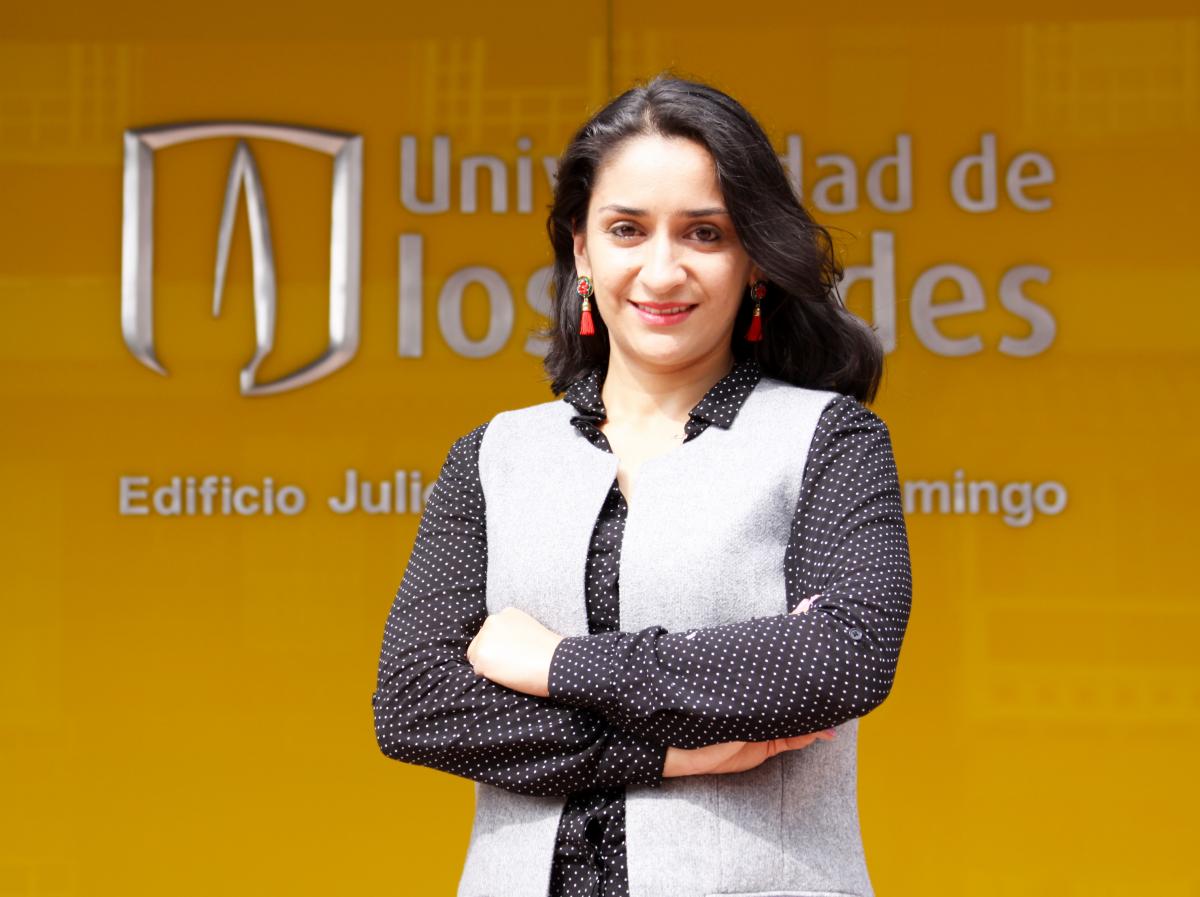Applications
 Part of the Oxford Instruments Group
Part of the Oxford Instruments Group
Expand
Collapse


Dr Giraldo-Gallo is recognised for her contributions to the understanding of a variety of novel superconductors – ranging from low-carrier-density semiconductors to the cuprates, with a special focus on magneto-transport measurements in ultra-high magnetic fields to characterise the normal state of such superconductors, the state from which superconductivity originates.
"It truly is an honour to be the recipient of the Lee Osheroff Richardson Science Prize this year. I receive it as a recognition of the hard work of a team of talented and remarkable scientists that have walked with me along this fun path of understanding novel ground states of quantum materials. I dedicate this prize to my mentors and collaborators throughout these years", commented Dr Giraldo-Gallo.
As a graduate student, Giraldo‐Gallo studied (Ba,Pb)BiO3, a material that has been around for more than 40 years, yet remained interesting due to the many unanswered questions regarding the mechanism of superconductivity, the shape of the superconducting dome versus lead doping, and the relationship of the superconducting phase with a charge density wave phase. Giraldo‐Gallo discovered the microscopic details of a structural phase separation in this system that determines the macroscopic observations, including the macroscopic superconducting transition temperature (Tc), implying that (Ba,Pb)BiO3 has the potential of being a superconductor with a much higher Tc, possibly three times higher, similar to the related compound (Ba,K)BiO3. Dr Giraldo‐Gallo’s work on (Ba,Pb)BiO3 represents a remarkable advancement in our knowledge of this important superconductor. As a result, there has been a renewed and increasing interest in bismuthate superconductors to understand the relationship between superconductivity and charge density wave states.
After her PhD, Dr Giraldo‐Gallo applied for the most prestigious Jack E. Crow Postdoctoral Fellowship at the National High Magnetic Field Laboratory (NHMFL) and was unanimously chosen by the selection committee.
As a postdoctoral researcher, Dr Giraldo‐Gallo established herself as an fully independent researcher through her work on the high‐temperature superconducting compound, (La,Sr)2CuO4. She was an independent agent in the laboratory, developing next generation magneto‐transport techniques for use in the extremely challenging environment of pulsed magnets. Dr Giraldo‐Gallo’s improved techniques for pulsed magnetic fields provided the signal‐to‐noise, necessary to establish the surprising and striking fact that optimally‐doped (La,Sr)2CuO4 exhibits a linear magnetoresistance as well. This result has captured the imagination of superconducting theorists, as it suggests an additional critical behaviour in optimally‐doped cuprates that is both phenomenologically simple, yet difficult to incorporate into present theoretical scenarios that seek to explain the physics of high‐temperature superconductors.
Dr Giraldo‐Gallo is currently working on understanding the relation between quantum criticality, charge order and superconductivity in a variety of compounds, including the K‐doped bismuthate compound (Ba,K)BiO3, and some transition metal chalcogenides. For this, she has set up systems for single crystal growth from molten solutions, by electrochemical methods, and by physical vapor transport at the Universidad de Los Andes. She has already produced high‐quality single crystals on which she is performing transport, magnetic, X-ray diffraction and other microscopy characterisation measurements.
[1] P. Giraldo-Gallo, P. Walmsley, S.C. Riggs, L. Buchauer, B. Fauque, Chang Liu, B. Sangiorgio, N. Spaldin, A. Kaminski, K. Behnia, and I.R. Fisher. “Evidence of incoherent carriers associated with resonant impurity levels and their influence on superconductivity in the anomalous superconductor Pb1-xTlxTe”. Physical Review Letters 121, 207001 (2018).
Summary: In this paper, Giraldo-Gallo presents a combined experimental and theoretical study of the evolution of the Fermi surface of the anomalous superconductor Pb1−xTlxTe as a function of thallium concentration. Giraldo-Gallo performed a number of magnetotransport measurements (Shubnikov–de Haas oscillations and the Hall coefficient in DC magnetic fields up to 35 T and pulsed magnetic fields up to 60 T), as well as angle resolved photoemission spectroscopy and density functional theory calculations of electronic structure. Her results indicate that for Tl concentrations beyond a critical value, the Fermi energy coincides with resonant impurity states in Pb1−xTlxTe. The fact that the calculation finds a high density of states at the Fermi energy due to impurity states in the absence of nearby metallic bands implies that these impurity states at the Fermi energy provide the enhanced pairing interaction that gives rise to superconductivity. This is a highly unusual role for impurity states to play! This enhanced pairing interaction leads to an anomalously high temperature superconductivity in this material: Tc is an order of magnitude higher than the Tc’s observed in other semiconductors with similar carrier densities. This work provides important insight for advancing our understanding of three different topics in quantum materials: thermoelectricity, superconductivity of low carrier density compounds, and charge Kondo physics. Giraldo-Gallo grew the single crystals used in the experiments, did the entire sample preparation for experiments, wrote the proposal and performed the experiments at the NHMFL, analysed all the data, and wrote the manuscript.
[2] P. Giraldo-Gallo, J.A. Galvis, Z. Stegen, K.A. Modic, F.F. Balakirev, J.B. Betts, X. Lian, C. Moir, S.C. Riggs, J. Wu, A.T. Bollinger, X. He, I. Bozovic, B.J. Ramshaw, R.D. McDonald, G.S. Boebinger and A. Shekhter. “Scale-invariant magnetoresistance in a cuprate superconductor”. Science 361 (2018) 479.
Summary: In this paper, Giraldo-Gallo reports strikingly unusual high-field magnetoresistance in the thin film cuprate superconductor, La2–xSrxCuO4, in the vicinity of critical doping. The anomalous metallic state in the high-temperature superconducting cuprates is masked by superconductivity near a quantum critical point. Applying high magnetic fields to suppress superconductivity has enabled detailed studies of the normal state, yet the direct effect of strong magnetic fields on the metallic state is poorly understood. She performed magnetoresistance measurements to the highest-quality (La,Sr)2CuO4 thin films ever grown, and in the highest non-destructive magnetic fields available. Her results reveal that the metallic state exposed by suppressing superconductivity is characterized by magnetoresistance that is linear in magnetic fields up to 80 tesla. The magnitude of the linear-in-field resistivity mirrors the magnitude and doping evolution of the well-known linear-in-temperature resistivity that has been associated with quantum criticality in high-temperature superconductors. Both the cuprates and the pnictides exhibit this simple form of magnetic scale invariance, revealing another universal characteristic of high-temperature superconductors. Giraldo-Gallo’s measurements furthermore establish that the linear magnetoresistance at very high fields coexists with linear-in-temperature resistivity in the strange metal state in the cuprates. This property, which differs from observations in the pnictides, is yet to be understood and must be incorporated into theories that aim to explain the mechanism of high temperature superconductivity through an understanding of the strange metal state. Giraldo-Gallo led both the sample preparation and the 80T pulsed magnetic fields experiments in the
NHMFL; She also performed the entire data analysis and led the manuscript writing.
[3] P. Giraldo-Gallo, B. Sangiorgio, P. Walmsley, H.J. Silverstein, M. Fechner, S.C. Riggs, T.H. Geballe, N. Spaldin, and I. R. Fisher. “Fermi surface evolution of Na-doped PbTe studied through density functional theory calculations and Shubnikov-de Haas measurements”. Physical Review B94 (2016) 195141. Editor's suggestion.
Summary: In this paper, Giraldo-Gallo presents a combined experimental and theoretical study of the evolution of the low-temperature Fermi surface of the low-carrier-density semiconductor, Lead Telluride (PbTe) when holes are introduced through sodium (Na) substitution on the lead site. Shubnikov-de Haas measurements taken in magnetic fields up to 35T (DC magnet) and 60T (pulsed magnet) show that DFT calculations underestimate the energy difference between the first valence band maxima at the L point, and the secondary valence band maxima (at the sigma point) in this compound. To whit, our data are consistent with a single-band Fermi surface over the entire doping range studied, whereas the calculations predict an occupation of the secondary pockets at intermediate doping. Our results are consistent with a non-parabolic Kane-model dispersion, in which the L pockets are ellipsoids of fixed anisotropy throughout the band, but the effective masses depend strongly on Fermi energy. This work is the most complete and comprehensive work to date on the Fermi surface evolution of (Pb,Na)Te for low and intermediate Na compositions. It provides important experimentally determined physical quantities needed for calculating and understanding the origin of important thermoelectric quantities, particularly the high thermoelectric figure of merit observed in doped PbTe. Giraldo-Gallo grew the single crystals used in the experiments, did the entire sample preparation for experiments, wrote the proposal and performed the experiments in the NHMFL, analysed all the data, and wrote the manuscript.